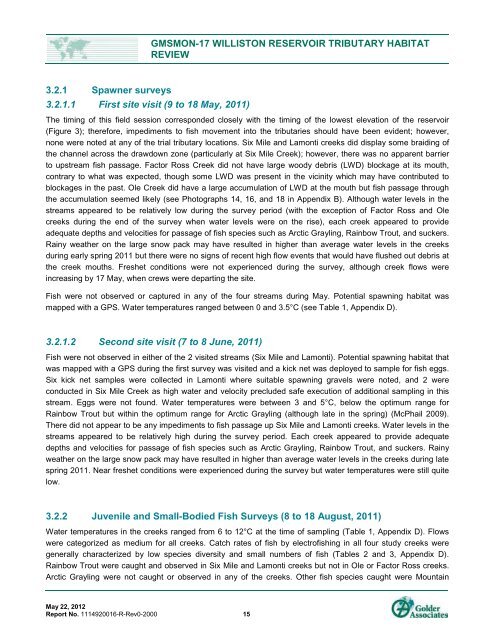GMSMON-17 WILLISTON RESERVOIR TRIBUTARY - BC Hydro
GMSMON-17 WILLISTON RESERVOIR TRIBUTARY - BC Hydro
GMSMON-17 WILLISTON RESERVOIR TRIBUTARY - BC Hydro
Create successful ePaper yourself
Turn your PDF publications into a flip-book with our unique Google optimized e-Paper software.
3.2.1 Spawner surveys<br />
3.2.1.1 First site visit (9 to 18 May, 2011)<br />
May 22, 2012<br />
Report No. 1114920016-R-Rev0-2000 15<br />
<strong>GMSMON</strong>-<strong>17</strong> <strong>WILLISTON</strong> <strong>RESERVOIR</strong> <strong>TRIBUTARY</strong> HABITAT<br />
REVIEW<br />
The timing of this field session corresponded closely with the timing of the lowest elevation of the reservoir<br />
(Figure 3); therefore, impediments to fish movement into the tributaries should have been evident; however,<br />
none were noted at any of the trial tributary locations. Six Mile and Lamonti creeks did display some braiding of<br />
the channel across the drawdown zone (particularly at Six Mile Creek); however, there was no apparent barrier<br />
to upstream fish passage. Factor Ross Creek did not have large woody debris (LWD) blockage at its mouth,<br />
contrary to what was expected, though some LWD was present in the vicinity which may have contributed to<br />
blockages in the past. Ole Creek did have a large accumulation of LWD at the mouth but fish passage through<br />
the accumulation seemed likely (see Photographs 14, 16, and 18 in Appendix B). Although water levels in the<br />
streams appeared to be relatively low during the survey period (with the exception of Factor Ross and Ole<br />
creeks during the end of the survey when water levels were on the rise), each creek appeared to provide<br />
adequate depths and velocities for passage of fish species such as Arctic Grayling, Rainbow Trout, and suckers.<br />
Rainy weather on the large snow pack may have resulted in higher than average water levels in the creeks<br />
during early spring 2011 but there were no signs of recent high flow events that would have flushed out debris at<br />
the creek mouths. Freshet conditions were not experienced during the survey, although creek flows were<br />
increasing by <strong>17</strong> May, when crews were departing the site.<br />
Fish were not observed or captured in any of the four streams during May. Potential spawning habitat was<br />
mapped with a GPS. Water temperatures ranged between 0 and 3.5°C (see Table 1, Appendix D).<br />
3.2.1.2 Second site visit (7 to 8 June, 2011)<br />
Fish were not observed in either of the 2 visited streams (Six Mile and Lamonti). Potential spawning habitat that<br />
was mapped with a GPS during the first survey was visited and a kick net was deployed to sample for fish eggs.<br />
Six kick net samples were collected in Lamonti where suitable spawning gravels were noted, and 2 were<br />
conducted in Six Mile Creek as high water and velocity precluded safe execution of additional sampling in this<br />
stream. Eggs were not found. Water temperatures were between 3 and 5°C, below the optimum range for<br />
Rainbow Trout but within the optimum range for Arctic Grayling (although late in the spring) (McPhail 2009).<br />
There did not appear to be any impediments to fish passage up Six Mile and Lamonti creeks. Water levels in the<br />
streams appeared to be relatively high during the survey period. Each creek appeared to provide adequate<br />
depths and velocities for passage of fish species such as Arctic Grayling, Rainbow Trout, and suckers. Rainy<br />
weather on the large snow pack may have resulted in higher than average water levels in the creeks during late<br />
spring 2011. Near freshet conditions were experienced during the survey but water temperatures were still quite<br />
low.<br />
3.2.2 Juvenile and Small-Bodied Fish Surveys (8 to 18 August, 2011)<br />
Water temperatures in the creeks ranged from 6 to 12°C at the time of sampling (Table 1, Appendix D). Flows<br />
were categorized as medium for all creeks. Catch rates of fish by electrofishing in all four study creeks were<br />
generally characterized by low species diversity and small numbers of fish (Tables 2 and 3, Appendix D).<br />
Rainbow Trout were caught and observed in Six Mile and Lamonti creeks but not in Ole or Factor Ross creeks.<br />
Arctic Grayling were not caught or observed in any of the creeks. Other fish species caught were Mountain
















